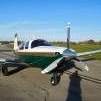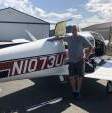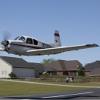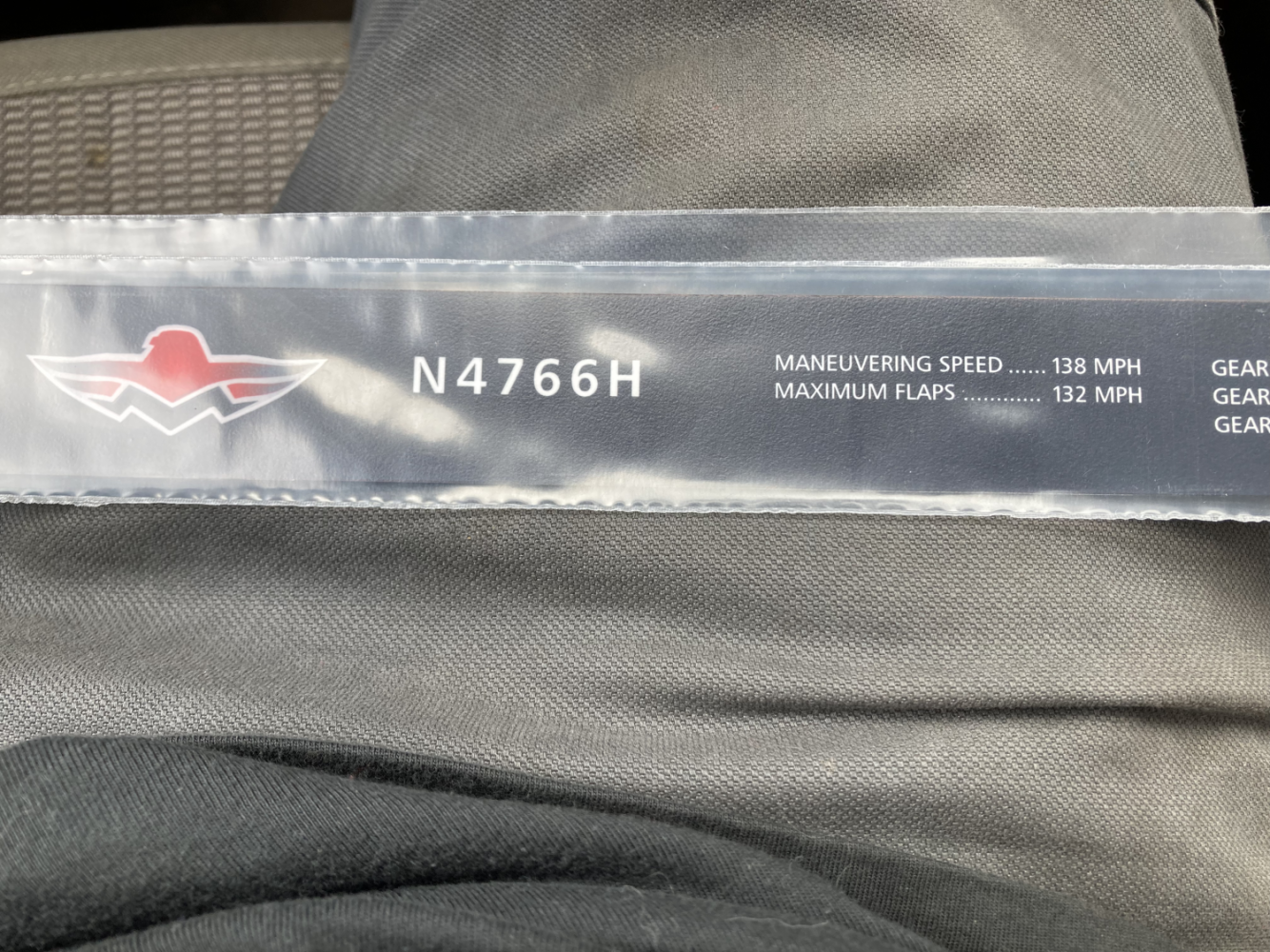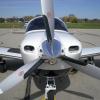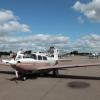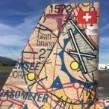Leaderboard
Popular Content
Showing content with the highest reputation on 10/02/2022 in all areas
-
I've experienced this a few times in other airplanes. It sounded like your transmissions were broken, yet somewhat readable. To rule out a failure of the Capt. side PTT...start with these: Reach over to the F/O side PTT and see if that works. Switch radios (assuming you have more than one). Use your handheld microphone (assuming you have one). Try using a handheld comm radio, like a Yaesu, Icom, etc. (albeit, this has limited range if not connected to an aircraft antenna). Squawk 7600 so ATC knows you have a comm failure and can manage you accordingly. If I may, a couple of unsolicited pieces of advice based on your video... When clearing a runway, announce "clear of Runway XXX" rather than "clear of the active". Too many people use "the active", and it's really annoying, not to mention procedurally incorrect. Regardless of how many runways are in use at any airport, everyone needs to know where you are. They cannot assume - nor should you expect them to know - what "the active" is if they haven't landed or taken off yet, as a runway can change any time. When you were asked to keep your speed up on final, you acknowledged it, and made a comment about "landing long". There is no such thing. The proper term is "a long rollout", and it's something you should ask ATC for permission to do, as they expect you to turn off at the first-available and suitable runway exit. Without asking them and getting it approved, you may be forcing other traffic on short final behind you to go around unnecessarily. Lastly, if you're not comfortable with accepting an ATC instruction to keep your speed up on final, go around. Forcing the airplane to slow down quickly only helps de-stabilize the approach, which can lead to bad things. Hope this all helps. Good luck with the PTT issue, and let us know how it turns out. Steve4 points
-
Next time you have the cowl off check that it wiggles, i.e., the sphere isn't seized in the rod end. It may have seized and caused the bow when you pulled it, which prevented it from moving, and it let go when you poked at it. If it gives you any more odd feelings, maybe shoot some lube at it. Just a speculative thought.4 points
-
You have to move your headset mic connection to the passenger side for the co-pilot PTT to work. Usually it is not practical.2 points
-
Yeah, that's a good way to handle it. You're setting proper expectations by keeping them advised as to your intentions. If I choose to accept a request to keep speed up on final (in the Ovation anyway), I generally tell ATC "I can give you 150kts to the gate, and then I need to slow it up...will that work?". This lets them know you have control of the situation, are setting expectations, are able to safely keep the approach stabilized, and touch down at the acceptable speed to make a "normal" turnoff.2 points
-
2 points
-
When I first got my 231 I thought I might need it, but not anymore. The plane does not need rudder trim at cruise at all, which is most of the time. The rudder is needed if at all on takeoff, the initial climb, and then turnout to your cruise course. There are constant changes during that period and they need to be made manually, or should I say pedally. During a long climb to altitude the plane can be a little out of trim but so little it would not be worth the cost of a rudder trim.2 points
-
I would take that bet, provided you filled up your billfold. Mooney, the owner of the logos and trademarks, sent that one to the paint shop for that paint job. That is Acclaim Serial #2. Either Tejas in San Marcos or Corrigans in Hondo (the two shops Mooney was using back then) had permission from Mooney to paint it.2 points
-
Check the timing listed on the data plate. I reviewed the TCDS as well as the Lycoming Operator’s manual. Both of those documents list 25° as the specified setting with no mention of an alternative option. 20° does not appear to be an approved setting for any O360 that Mooney installed.2 points
-
2 points
-
Well, I'm hopefully going to get it off jacks tomorrow after I check the gear door rigging and do a run up. If not, in the next day or two after that. Mine didn’t seem to have much grease in it from the factory, and there was quite a bit of air that came out when I took the plug out of one side. I assume I’ll know rather quickly if the prop cycle is sluggish and if there is grease on the windshield?1 point
-
It seemed like the PTT had a bad contact. It was intermittent. I did consider using the co-pilot yoke PTT but it’s in a really awkward position so was trying to make mine work first. I did have a handheld radio, so worst case I could have defaulted to that. Thanks for all the comments, much appreciated!1 point
-
To be honest I'm not sure exactly what "the gate" is, but I'm open to throwing in the term if I can figure it out - I do enjoy trying to sound like the pros flying jets1 point
-
ECP OH was so reasonable, I just went with the OH. I think I paid ~$1700 in 2017 and they picked it up and delivered it to my hangar. Randy told me it has enough blade left for at least one more overhaul.1 point
-
Your experience with the C model is typical. Idle mixture only matters when idling - it has zero effect on climb/cruise temps, so your mechanic missed the mark there. Your temps as described in climb are actually a bit better than average considering the Powerflow. Mine came with the cowl closure so I have nothing to compare to, but I've heard multiple folks say it made zero perceptible difference for them in terms of cooling or cruise speed.1 point
-
Good tips from a presumptive pro. Looks like he touched down right on the aiming point and made the requested turnoff so it wasn't a "long" landing. I suppose a long landing doesn't matter much from an ATC perspective, and a long rollout would be needed primarily due to slippery runway conditions. I've always wondered how best to handle it when told to keep my speed up. I generally acknowledge, and then say I need to slow to 105 kt for my gear speed just before the FAF if on an approach or on 2 mi final if visual.1 point
-
So I’m flying now and don’t see tfrs being updated… but the time stamp on my FF says they were updated 20 minutes ago and I was airborne. On the Devices page I don’t see a TFR block to even show a time?1 point
-
I'm pretty sure they all have a doghouse, which is a piece of dogsh*t in my view. Crap mixture distribution via the carb is another offender, and perhaps the dominant one - It's really just #2 and #4 that have the issue for me (both in climb and cruise) - the other two cool nicely, even after putting in a Powerflow exhaust and advancing timing at lower power settings via the Surefly mag. You really need to have the richer carb option on these engines also. From '68 onward they fixed the cowl flap position on the C, which I suspect didn't help either. I've "illegally" retarded baseline timing to -23ish on mine but it didn't noticeably help. At high CHTs, I think there is a cylinder longevity issue, maybe not in the low 400s though. My hottest cylinder in climb (#4) actually lasted longer (~1350 hrs) than the other 3 before needing to be reworked - it rarely went any higher than the 430s in climb though, even on the hottest day. When my blowby-related oil consumption rose to 1qt/3hrs and #4 had a consistently oily bottom plug, I figured it was time and I replaced #4 with factory new, hoping to make it another several hundred hours before overhauling. After 1.5 years and 200 hours, oil consumption is back down to 1qt/3hrs, the crosshatch looks polished out of #4, and it now also has an oily TOP plug . A little while before swapping #4, the Powerflow went in, which made it commonplace to break CHTs of 450 on that cylinder in climb, and I gotta think that's what led to the premature wear. Now I leave the throttle out 1 inch when going to full power on the runway - this has barely perceptible effect on MP and fuel flow but keeps #2/4 CHTs in early climb below 420 generally. It must be improved mixture distribution that occurs here, though I think they also cool worse from an airflow perspective. I wish I'd figured this out when #4 was brand new instead of abusing it so badly1 point
-
The prop shop won’t have it any other way. They hav been inundated with reseals over the last several years. I would recommend you IRAN well before you get close to calendar time. My shop (East Coast Propeller) refused to IRAN my prop at 9 years and 650SPOH. They will no longer IRAN/reseal props within certain window of calendar TBO. I as told that the policy was driven by liability concerns.1 point
-
This unfortunately is a quality issue with AeroShell 6. As Hartzell has highlighted in letters to shops and owners, for some reason Shell changed the formulation of AeroShell 6 sometime in the mid 2010's. It breaks down sooner than earlier formulations. I have a full feathering Scimitar that was overhauled and refilled with AeroShell 6 at a Hartzell Service Center in 2015. In 2021 I started seeing streaks on the blades. Then it got worse and started spattering a film on the windshield. The warm climate I am in probably makes it worse. Also the full feathering exercises the seals more on mine. As a result I had a reseal done early this year at a Hartzell Service Center using NYCO GN3058. In January 2020 Hartzell completely discontinued use of all AeroShell products and started shipping all new props exclusively with NYCO GN3058. It is synthetic and NOT COMPATIBLE with AeroShell. The props have a placard that warn your A&P - if they burp it with crap AeroShell they will be paying for a complete reseal.1 point
-
1 point
-
They recommend 1 ounce or when grease comes out whichever is first. There is tribal wisdom that 1 oz is six pumps, but it is highly dependent on the type of grease gun you have. It is recommended to check your gun to see how many pumps are required for 1 oz. Guns that can do high pressure may take many more than 6, and if you have a quality name brand gun the documentation for it might even say how many pumps per oz or particular volume metric. If you assume 6 pumps, you may be getting much less than an ounce, depending.1 point
-
What about in FF or G Pilot on you iPad? Can you tell if GTX is receiving the data and it's making it through to the iPad? I have a GTX-345 as well and think I'm taking a flight tomorrow. We have one permanent TFR here, but I'll see if I can find any while in the air somewhere that wouldn't have been pulled down in my Brief.1 point
-
Mountain high O2D2 with whatever tank you like. It’ll make your bottle last forever, automatically goes on at a set altitude and works flawlessly1 point
-
So weird one today…. Departing for a vfr flight to Glacier National Park for a weekend of hiking and scenery. Doing the runup, can’t cycle the prop. Control moved about an inch but felt weird and wouldn’t move past that point. Taxied back to hangar thinking WTF? Realized that the last thing I did was an oil change with my IA. Filter is right above the prop governor. Weird, but gotta be connected, right? Take off all the cowlings at the hanger and look. Nothing seems amiss. Safety wire from the filter is maybe close to the cable but not touching. Then I think the solid sleeve around the end of the prop governor control cable is maybe very slightly bent? I pull up on it a little and move the control myself. And it moves smoothly. I have my wife try it from the cockpit and now it moves smoothly there as well. Weird. I mean it went from jammed to totally smooth again. It wasn’t creased or even obviously bent. It was a super slight bow. Airplane flew great after that. Anyone ever see that? Maybe my IA hit it with the torque wrench or safety wire tool? If he did it was pretty minor because I was right there and didn’t notice.1 point
-
The AeroTrim works extremely well Had one on my J 201 back in 1980s for years. It was trouble free Norm Smith was a wonderful person and loved Mooneys I was surprised to see that aerotrim was still in production as Norm passed away in 2008. If you desire a rudder trim, get the aerotrim1 point
-
My Piper has rudder trim, and I definitely look like a more coordinated pilot in that a/c. I trim for each phase of flight, it takes two seconds, and the plane basically stays coordinated. In the Mooney, I have times during every flight where my attention is on something else and the ball gets out of center (especially on a long initial climb to cruise altitude). Neither plane needs rudder trim, and it’s worth zero dollars for me to add it. But since the factory put it on the Piper, I do use it, and I look less sloppy flying it1 point
-
Or just mount the GMU in the tail, where I think they usually are.1 point
-
Don’t tell them it’s a Rocket. The registration still says M20K doesn’t it? Does everyone need to disclose what STCs they have before they get an autopilot installed.1 point
-
Tom The FAA very much recommends that field approvals be submitted prior to starting the work. While I haven’t done one post COVID, and they are not like the old days, some FSDO’s work closely with the Certification Office on field approvals. The last package I did was as comprehensive as a one time STC, but they were cooperative. It included certification plan, approved flight manual supplement and ICaW. Unfortunately there are still inconsistencies between locations. I hope you are able to get this done.1 point
-
With some more testing with me pretty useless except for running the engine while the a&p measured everything he could get his multimeter on, we(he) decided it was the alternator. That’s been replaced and it’s working fabulously. Really happy to be finally flying it and learning to fly this fun airplane. Thank you all for the different insights and help1 point
-
Yes, apparently it's been in the pipeline for a while, and iirc it may be accompanied with some certification category changes or additions. I think it's not been too widely publicized since it has been under development and not yet stable. Supposed to be a pretty big change, though. We'll see what really shakes out if/when it happens.1 point
-
Great Trip to Jackson (McKellar-Sipes) and Rockwood! This Mooney is amazing -- 148 knots true and 7.1 GPH block time! I have the fuel receipt to prove it! Key #s were 2300 RPM and 21" MAP (44 Key#). Landing at Rockwood was crazy -- winds varied from 330-070 and 9 knots gusting to 22! Was quite a challenge! G5 HSI shows the 37 mph winds (varied 35- 45 mph) I had to deal with. Pics of the settings, the trip time to MKL (which I was using to track fuel consumption) and video!1 point
-
It doesn't sound like you're overfilling the hub if you're putting in just a couple pumps/year and nothing is coming out the opposite fitting. It is worth knowing what grease was put in the hub at last reseal - generally its Aeroshell 5 (thicker) vs. Aeroshell 6 (thinner). I bet you have 6, which has a reputation for breaking down and liquifying, generating a thin sheen that gets past the seals (not heavier nodular chunks, which would be more worrying). With just a small amount of this leaking and the low hours you're flying, I doubt the hub is at risk of running dry of grease , so I would be in no rush to do another reseal job. I've been living with a similar issue for a few years now flying 100-150 hrs/year, adding a few squirts #5 at annual on top of the original #6 in the hub from factory new 11 years ago - it does immediately come out the opposite fitting for me. There is no problem with mixing the two greases.1 point
-
Eliminating some variables might help you through this. Did the high CHT's exist before the engine overhaul or are they new after the engine overhaul? W/ overhaul was carb and mags rebuilt? Sounds like you have the original single cht gauge and single probe on #3 cylinder. gauge/probe are reading ambient prior to start but we don't know if still calibrated through range. You could try sticking probe in coffee cup of boiling water to get an idea at mid range. if you have a fluke meter with temperature probe (or a thermometer that reads that high) you could using a heat gun or hair dryer to get an idea of calibration at higher temp. you heat both probes using fluke as your reference, be careful not to overheat things but you can get a fairly accurate reading if you control your heat slowly and allow things to reach steady state. Baffles and seals can't be minimized, small gaps are huge pressure drops that take all the airflow and reduces airflow through the fins. looks good is not the same as "we think we have high cht readings and want to make sure all the air is getting pushed through the fins. really scrutinize your baffles, look where the silicone material is spliced and around corners to see how it all fits with cowling in place. The Lasar cowling closure is more looks than improving cooling. Mooney SB M20-182 is for the the E&F with io-360 but you can see that what they were trying to do was close off air through the fins on no 1&2 cylinder to force more through 3 and 4 and then out the bottom through a new exit scoop (side note if anyone has this on their E&F I would like to measure so I can fabricate) once you knock off some variables this will get less complex for the record engineering nerd and life time wrench turner not an A&P1 point
-
A number of us have had them on order for some time and have either had orders cancelled or other issues, after long delays. Last week AS told me it'd be another 120 days and I needed to either cancel or pre-pay with a No Cancel No Return policy. It's been a very strange ride. It's even stranger if they're starting an ad campaign now.1 point
-
With the amount of transactions you do they have one person assigned just to you1 point
-
1 point
-
The 310 hp STC and three blade prop for the Ovations increases the need for right rudder under full power take-off and extended climb conditions. While the airplane is fully controllable and quite capable WITHOUT rudder trim, the use of trim to take out the right rudder pressure needed on long climbs can reduce leg fatigue. I have no experience on a M20K but unless your leg tires now in T/O or climb conditions, the trim is not going to do anything.1 point
-
I really don't think you'll notice a huge difference even when you jump through all of the hoops to get this approved. I had a 231 (210hp) and never felt the need for rudder trim. After that I owned a Bravo (long body with 270hp, 3 blade prop) and I only forgot to have rudder trim set once and never forgot again - a lot of p-factor on that set-up. Later I owned an Encore (220hp, 2 blade) with the S-Tec yaw damper and never felt the need for rudder trim. To do everything that's gong to be required you'll have thousands into it and I don't think it will be world-changing. It looks like a solution in search of a problem. One more thing: When Mooney did the M20S (Eagle), it had 244hp and they did not include rudder trim. On the 280hp and 310hp STC's for the Eagle, in my opinion, the FAA should have required that rudder trim be added. If a pilot transitioning to a 310hp Eagle w/o rudder trim had a distraction on take-off (maybe seat slides back) that could be a handful. A few years ago there was an accident of this type in Kansas in a newly-purchased 310hp Eagle on take-off, which turned into a sad disaster.1 point
-
This is true. In the past, I had several bad experiences with mx facilities. Even the first owner assist I did was off putting. I pulled the flap pump and exhaust by myself. I walked into the office to talk to the IA who was everywhere but in the shop (at the FBO, riding his 4 wheeler around ,etc). He's sitting at his desk facing me and I kid you not, a pop up opens on the screen over his shoulder with some very graphic content. I did most of the work that annual while he rode his four wheeler, drank FBO coffee and wanked in his office. He did check my work and give me access to tools, though I was less enthused about touching them after the office incident . The inspection cost me $2500 plus squawks in 2006. I kept shopping and now have at least three solid guys that I can work with.1 point
-
1 point
-
It probably would. Just have a mechanical engineer draw it up, Submit it to a DER and the FAA for their opinion. If the FAA inspector agrees that he will sign off on it, Have the DER do a full engineering evaluation and submit the drawing package along with the DER analysis to the FAA inspector for approval. After you get approval, then you can install it. This gives you a field approval AKA one time STC. If you wanted to get a real STC, you would need to get a PMA for all the parts and voilà! In the airplane business. If Norm can do it in his garage, anybody can.1 point
-
Same thing, actually, there's a drain hose that exits at the bottom of the cowl, supposed to be out the left cowl flap. If it is dripping fuel or oil it means one of the diaphragms is leaking and the pump needs to be replaced. The crankcase breather tube exits at the left cowl flap and normally drips a little oil, and it's the large tube there. If any of the smaller tubes or drains around there are dripping anything it should be checked, as it is likely indicative of a problem.1 point
-
How many connections do you think your Mooney has between your volt meter and the alternator? Starting at the battery… Alternator switch… Master relay… Avionics master relay… Voltage regulator… Alternator… Grounds… Some mechanics are really good with electrical challenges…. Including the drawings they need on hand…. Some mechanics know where the big issues are often found… Around here… the field wire is always suspect… They break most often…. They also control what the alternator is doing… If the field wire breaks… the alternator stops working… loose connection is similar… How old is the battery, has it had a capacity check? Nice clean connections can always be helpful… Don’t replace anything until it’s connections have been tested, cleaned, or determined how old the things are… PP thoughts only, not a mechanic… Best regards, -a-1 point
-
500fpm descent is helpful… 400fpm descent is better for getting the altitude back as forward speed… Assuming smooth air…. Either way…. You probably need to pull the power back significantly if using 500fpm… See if you can catch that MAPA class… Those numbers were generated based on actual CFIIs that fly those planes… If something doesn’t make sense… it makes a great discussion in that class…. Best regards, -a-1 point
-
A part of all this I find most unfortunate and disgusting…….many years ago (1972), I was required to undergo an FBI background check in order to receive a secret clearance for my employment at Vandenberg Air Force Base. Several decades later, when the administration folks at SMX implemented their all imprisonment of our airport, I had to undergo a very similar background check in order to receive a badge to be able to access my private aircraft. Pathetic….. we’ve come such a long sad way!1 point
-
It’s done! Passed the ck ride! Long story short said I did a great job on approaches. Finally after 25 years… -Don1 point
-
1 point
-
Hello from Gibraltar! I can't believe this all worked out. In Swiss German this was what's called a Mwurks - like trying to fit a square peg in a round hole through asking, begging, coercing, forcing... I got so lucky! Of the five available parking spots, EasyJet and British Airways are taking four. At the very last minute (one hour before arrival from an airport one hour away) they let me have the fifth and then said, "Well, your plane is so small. If we have to, we can just move it somewhere."1 point
-
It’s killing me to take so long! Marauder is still first if he’s still wanting it when I get over my hurdles. Since I sold my Mooney a while ago, I didn’t have an airplane to fit parts to and prove my kits as I assemble them. I purchased a forward fuselage this spring along with an engine mount, prop hub, an spinner back plate. I’m waiting on O-360 crankshaft bearings so I can assemble the mock up engine and know that all my pieces fit correctly. I was hoping to find a used set of standard bearings as I don’t need airworthy parts. If anyone has any laying around and wants to part with them, let me know. The bearings are the last items I need to ensure my cowling fits correctly and then I can have the mold corrected. Still making progress, just way slower than I want to be. Thanks, David1 point


